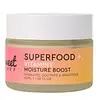What's inside
What's inside
 Key Ingredients
Key Ingredients

 Benefits
Benefits

 Concerns
Concerns

 Ingredients Side-by-side
Ingredients Side-by-side

Water
Skin ConditioningGlycerin
HumectantButylene Glycol
HumectantPalmitic Acid
EmollientStearic Acid
CleansingEthylhexyl Stearate
EmollientEthylhexyl Palmitate
EmollientCaprylic/Capric Triglyceride
MaskingHydrogenated Poly(C6-14 Olefin)
EmollientNiacinamide
SmoothingCeramide AP
Skin Conditioning1,2-Hexanediol
Skin ConditioningPolyglyceryl-3 Methylglucose Distearate
EmulsifyingPolymethylsilsesquioxane
Tromethamine
BufferingBrassica Oleracea Acephala Leaf Extract
HumectantZingiber Officinale Root Extract
MaskingBeta Vulgaris Root Extract
Skin ConditioningGanoderma Lucidum Stem Extract
Skin ConditioningMelia Azadirachta Flower Extract
Skin ConditioningPanthenol
Skin ConditioningEthylhexylglycerin
Skin ConditioningMelia Azadirachta Leaf Extract
Skin ConditioningCurcuma Longa Root Extract
MaskingOcimum Sanctum Leaf Extract
Skin ConditioningAdenosine
Skin ConditioningSodium Hyaluronate
HumectantSodium Phytate
Tocopheryl Acetate
AntioxidantCorallina Officinalis Extract
Skin ConditioningAlthaea Rosea Flower Extract
Skin ConditioningAscorbic Acid
AntioxidantGlycine Soja Oil
EmollientPanax Ginseng Extract
AntioxidantCaprylyl Glycol
EmollientCandida Bombicola/Glucose/Methyl Rapeseedate Ferment
AntimicrobialSpirulina Platensis Extract
Skin ProtectingAvena Sativa Kernel Oil
Skin ConditioningAcrylates/C10-30 Alkyl Acrylate Crosspolymer
Emulsion StabilisingCitrus Junos Fruit Extract
Skin ConditioningCoffea Arabica Seed Extract
MaskingGossypium Herbaceum Seed Oil
Skin ConditioningMoringa Oleifera Seed Extract
Skin ConditioningRetinol
Skin ConditioningSalvia Hispanica Seed Oil
MoisturisingSesamum Indicum Seed Oil
EmollientCaramel
Cosmetic ColorantLavandula Angustifolia Oil
MaskingWater, Glycerin, Butylene Glycol, Palmitic Acid, Stearic Acid, Ethylhexyl Stearate, Ethylhexyl Palmitate, Caprylic/Capric Triglyceride, Hydrogenated Poly(C6-14 Olefin), Niacinamide, Ceramide AP, 1,2-Hexanediol, Polyglyceryl-3 Methylglucose Distearate, Polymethylsilsesquioxane, Tromethamine, Brassica Oleracea Acephala Leaf Extract, Zingiber Officinale Root Extract, Beta Vulgaris Root Extract, Ganoderma Lucidum Stem Extract, Melia Azadirachta Flower Extract, Panthenol, Ethylhexylglycerin, Melia Azadirachta Leaf Extract, Curcuma Longa Root Extract, Ocimum Sanctum Leaf Extract, Adenosine, Sodium Hyaluronate, Sodium Phytate, Tocopheryl Acetate, Corallina Officinalis Extract, Althaea Rosea Flower Extract, Ascorbic Acid, Glycine Soja Oil, Panax Ginseng Extract, Caprylyl Glycol, Candida Bombicola/Glucose/Methyl Rapeseedate Ferment, Spirulina Platensis Extract, Avena Sativa Kernel Oil, Acrylates/C10-30 Alkyl Acrylate Crosspolymer, Citrus Junos Fruit Extract, Coffea Arabica Seed Extract, Gossypium Herbaceum Seed Oil, Moringa Oleifera Seed Extract, Retinol, Salvia Hispanica Seed Oil, Sesamum Indicum Seed Oil, Caramel, Lavandula Angustifolia Oil
 Reviews
Reviews

Ingredients Explained
These ingredients are found in both products.
Ingredients higher up in an ingredient list are typically present in a larger amount.
Niacinamide is a multitasking form of vitamin B3 that strengthens the skin barrier, reduces pores and dark spots, regulates oil, and improves signs of aging.
And the best part? It's gentle and well-tolerated by most skin types, including sensitive and reactive skin.
You might have heard of "niacin flush", or the reddening of skin that causes itchiness. Niacinamide has not been found to cause this.
In very rare cases, some individuals may not be able to tolerate niacinamide at all or experience an allergic reaction to it.
If you are experiencing flaking, irritation, and dryness with this ingredient, be sure to double check all your products as this ingredient can be found in all categories of skincare.
When incorporating niacinamide into your routine, look out for concentration amounts. Typically, 5% niacinamide provides benefits such as fading dark spots. However, if you have sensitive skin, it is better to begin with a smaller concentration.
When you apply niacinamide to your skin, your body converts it into nicotinamide adenine dinucleotide (NAD). NAD is an essential coenzyme that is already found in your cells as "fuel" and powers countless biological processes.
In your skin, NAD helps repair cell damage, produce new healthy cells, support collagen production, strengthen the skin barrier, and fight environmental stressors (like UV and pollution).
Our natural NAD levels start to decline with age, leading to slower skin repair, visible aging, and a weaker skin barrier. By providing your skin niacinamide, you're recharging your skin's NAD levels. This leads to stronger, healthier, and younger looking skin.
Another name for vitamin B3 is nicotinamide. This vitamin is water-soluble and our bodies don't store it. We obtain Vitamin B3 from either food or skincare. Meat, fish, wheat, yeast, and leafy greens contain vitamin B3.
The type of niacinamide used in skincare is synthetically created.
Learn more about NiacinamideWater. It's the most common cosmetic ingredient of all. You'll usually see it at the top of ingredient lists, meaning that it makes up the largest part of the product.
So why is it so popular? Water most often acts as a solvent - this means that it helps dissolve other ingredients into the formulation.
You'll also recognize water as that liquid we all need to stay alive. If you see this, drink a glass of water. Stay hydrated!
Learn more about Water